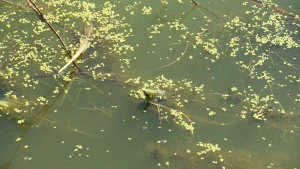Alberta, Canada – The province of Alberta has issued a blue-green algae advisory for several bodies of water due to the presence of harmful algae blooms. These advisories serve as a warning to the public to avoid contact with the affected water bodies.
According to the advisory, the following water bodies are currently under the blue-green algae advisory: Moose Lake, Pigeon Lake, and Lac La Nonne. The advisory also includes the entire shoreline of Lake Isle and the entire lake of Isle Lake.
Blue-green algae, also known as cyanobacteria, are microscopic organisms that can produce toxins harmful to humans and animals. These toxins can cause a range of health issues, including skin irritation, sore throat, fever, nausea, and vomiting. In severe cases, they can even lead to liver damage.
The advisory urges people to avoid all contact with the affected water bodies, including swimming, wading, and water sports. It also advises against consuming fish caught from these waters and using the water for drinking, cooking, or bathing.
The presence of blue-green algae is a natural occurrence, but it can be exacerbated by factors such as warm weather, excess nutrients, and stagnant water. The Alberta government is closely monitoring the situation and will continue to provide updates as necessary.
In the meantime, officials are reminding the public to be cautious and to report any sightings of blue-green algae to the Alberta Health Services Environmental Health at 1-877-247-7333.
It is important to note that not all algae blooms are harmful, and not all blue-green algae produce toxins. However, it is always best to err on the side of caution and avoid contact with any water that appears discolored or has a foul odor.
The blue-green algae advisory will remain in effect until further notice. The Alberta government is working to address the issue and ensure the safety of its citizens. For more information and updates, please visit the Alberta Health Services website.
In conclusion, the blue-green algae advisory serves as a reminder to the public to be mindful of their surroundings and to take necessary precautions to protect their health. By avoiding contact with the affected water bodies, we can help prevent any potential health risks. Let us all do our part in keeping our water bodies safe and healthy.




